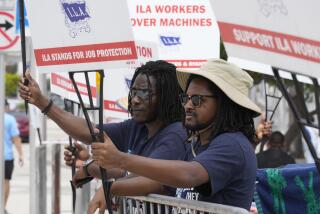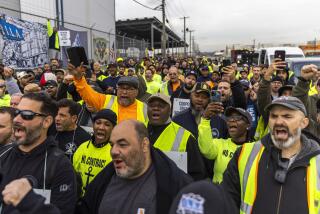As Strike of Ferryboat Workers in Dover Drags On, Deep Divisions Grow in Town
- Share via
DOVER, England — A strike of ferryboat workers has brought bitter division to this old English Channel port under the famed White Cliffs.
A vast majority of the Dover seamen of P & O European Ferries, the largest English Channel ferry operator, voted Feb. 2 to strike over new work practices the company wanted to impose.
Four months later the walkout remains unresolved, and the 2,220 workers are bitterly divided.
One side decided in late April to defy the National Union of Seamen and accept a revised P & O proposal to return to work.
The men and women who chose to stay out lost their jobs.
Some of those who returned to work have found the word “Scab” scrawled in red paint on their homes. Others have reported receiving threatening, anonymous telephone calls.
Brian Young, mayor of the city of about 40,000 people, fears that Dover will feel the pain longer after the strike is settled.
“You’re going to get splits in the community” he said. “People are having to make hard decisions.
“People rely on each other in an emergency out there when there is a 10-force gale. People will remember who didn’t back them up in a strike.”
P & O, which is refusing further negotiations with the union, says that 1,100 former strikers are back on the job. The union says it’s only 250.
Violence broke out on the picket lines April 29, when P & O operated two of its 11 ferries with strikebreaking crews.
The company says it now is operating five vessels, two carrying passengers and three carrying freight, and has brought its work force back to 65% of its previous level by hiring from a pool of 8,000 outsiders.
“What has happened here is a tragedy,” said striker Steve Bartlett. “I won’t speak to them (the strikebreakers) ever again. They betrayed us. They are traitors.”
The strikers say they won’t accept the new work rules--namely more shifts--on ground that they jeopardize ferry safety.
The loss of 193 lives, including ferry crewmen, in last year’s sinking of the P & O’s Herald of Free Enterprise off Zeebrugge, Belgium, had a profound effect on Dover, whose principal industry is its port, which goes back to Roman times.
But P & O insists that nothing in its work proposals is unsafe and that safety is a paramount issue with the company.
P & O maintains that it needs the new work practices to make it more competitive with the new English Channel rail tunnel, which will offer speedier travel between England and France when it opens in 1993.
The strikers, however, believe that P& O is trying to destroy their union with the backing of Prime Minister Margaret Thatcher’s Conservative government.
Dover residents who support the opposition Labor Party believe intensely that the chairman of the parent P & O Steam Navigation Co., Sir Jeffrey Sterling, has benefited from Thatcher’s capitalist policies.
Although Dover’s economy has been hurt by the walkout, large segments of the community appear to back the strikers.
“It’s always been a seafaring town, so these seamen have a lot of support,” said James Moore, a taxi driver.
Mayor Young said that shopkeepers donate food to the strikers, who have set up soup kitchens to guarantee that the seamen and their families get at least one hot meal a day.
The seamen, who made the equivalent of $20,500 to $31,600 a year, are having to make do now with a total of about $372 in strike payments from their union.
Crewmen who have gone back to work avoid talking about it to reporters.
More to Read
Sign up for Essential California
The most important California stories and recommendations in your inbox every morning.
You may occasionally receive promotional content from the Los Angeles Times.













